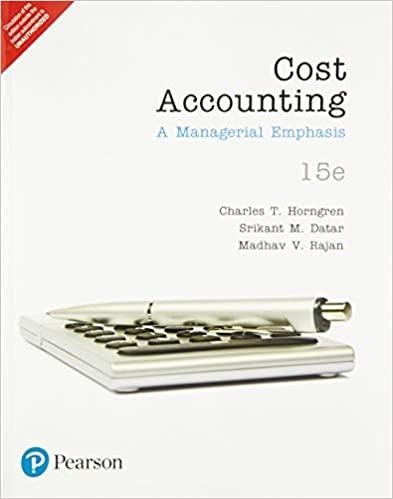Question
As this is a new store, merchandise has been purchased on account to sell at the store. The information below relates to the purchase and
As this is a new store, merchandise has been purchased on account to sell at the store. The information below relates to the purchase and sales of the new products.
Use the perpetual inventory method with the FIFO valuation method. Please see the Milestone Inventory tab in your workbook for purchase and sales information.
August 25: Purchased 15 golf club sets for $240 each to sell at the store from vendor A, on account with terms of 1/10 net 60.
September 16: Purchased 25 bicycles for $75 each to sell at the store from vendor B, on account with terms of 1/10 net 60.
September 24: Paid $750 toward merchandise from vendor A.
September 30: Recorded impact of sales transaction on COGS and the inventory asset.
October 18: Paid $650 toward merchandise from vendor B.
October 25: Paid remaining payable for merchandise from vendor A.
October 26: Purchased 25 more golf club sets for $250 each to sell at the store from vendor A, on account with terms of 1/10 net 60.
October 31: Recorded impact of sales transaction on COGS and the inventory asset.
November 10: Paid remaining payable for merchandise from vendor B.
November 16: Purchased 35 more bicycle sets for $85 to sell at the store each from vendor on account with terms of 2/10 net 30.
November 20: Paid vendor B in full and took advantage of the discount (offset COGS).
November 30: Recorded impact of sales transaction on COGS and the inventory asset.
December 10: Paid $4500 toward payable for merchandise from Vendor A.
December 31: Recorded impact of sales transaction on COGS and the inventory asset.
| Sales | Ending Inventory | |||
| Unit Price | Total Price | No. of Items | Unit Price | Total Price |
| [Insert value] | [Insert value] | #VALUE! | ||
| [Insert value] | #VALUE! | [Insert value] | [Insert value] | #VALUE! |
| [Insert value] | #VALUE! | |||
| [Insert value] | #VALUE! | [Insert value] | [Insert value] | #VALUE! |
| [Insert value] | #VALUE! | [Insert value] | [Insert value] | #VALUE! |
| [Insert value] | #VALUE! | [Insert value] | [Insert value] | #VALUE! |
| [Insert value] | #VALUE! | [Insert value] | [Insert value] | #VALUE! |
| #VALUE! | [Insert value] | #VALUE! | ||
| $- | [Insert value] | [Insert value] | #VALUE! | |
| [Insert value] | #VALUE! | [Insert value] | [Insert value] | #VALUE! |
| [Insert value] | #VALUE! | [Insert value] | [Insert value] | #VALUE! |
| [Insert value] | #VALUE! | |||
| [Insert value] | #VALUE! | [Insert value] | [Insert value] | #VALUE! |
| [Insert value] | #VALUE! | [Insert value] | [Insert value] | #VALUE! |
| [Insert value] | #VALUE! | [Insert value] | [Insert value] | #VALUE! |
| #VALUE! | [Insert value] | #VALUE! | ||
| VENDOR A | VENDOR B | |||
| [Insert value] | [Insert value] | |||
| #VALUE! | $- | |||
| $- | $- | |||
| $- | [Insert value] | |||
| $- | $- | |||
| #VALUE! | $- | |||
Step by Step Solution
There are 3 Steps involved in it
Step: 1

Get Instant Access to Expert-Tailored Solutions
See step-by-step solutions with expert insights and AI powered tools for academic success
Step: 2

Step: 3

Ace Your Homework with AI
Get the answers you need in no time with our AI-driven, step-by-step assistance
Get Started


